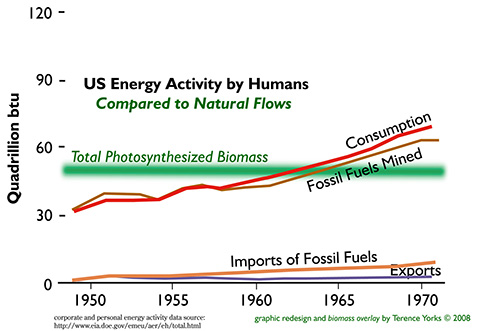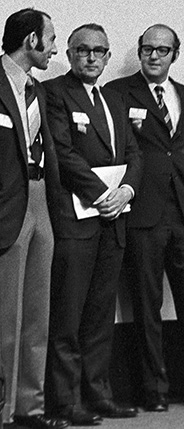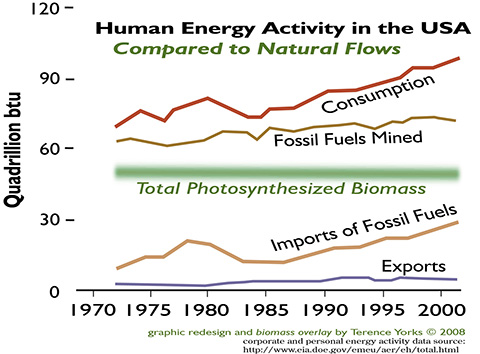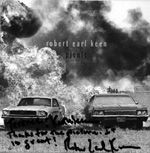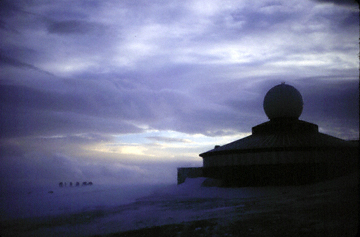
This
page shares several continuing attempts
to understand our world, somewhat less formally
than
what
is sketched within my experience or publications pages.
These creative examples tend neither to have found publishers for most of their
results, nor
the
effective
collaborators to optimize their wider utility.
Each has aspects, nevertheless, that have already produced substantial value, and could do much more. |
Categories: Research /Art / Teaching
Discovering the most comprehensive set of consequences from human use of energy and materials
[Distilled from my currently emerging memoirs]
What has consistently been missing from previous analytical pathways are more definitive and quantitative equivalents to the "red line" for engines in fine automotive machinery, or its parallel "never exceed speed" for aircraft. In either, an overall stress measurement marker can be seen to specifically point out no longer avoidable serious dangers, when critical structures become too likely to catastrophically disintegrate. The following graph parallels a simplified version that I saw presented in 1972 by NASA physicist W.R.. Cherry, then president of the International Solar Energy Society, that year at their annual meeting. My version posted below should reveal its central suggestion, which integrates a set of complex underlying factors to produce a decisive "green-warning-line" for our planet.
Leading up to this, that particularly quiet-spoken man had started with cumulative observations of how heat island effects from cities were measurably affecting local weather patterns. His conclusions were backed by extensive data that he had assembled from his own differently targeted studies in the St. Louis area. Searching for causes for differential heating pointed towards the immensely greater masses of buildings and pavement made from concrete or other heavy materials. These had replacing, at increasing rate, dramatically less dense, long-evolved complexes of native vegetation, which had for so long covered the ground near that city's center. Those heavy human constructs added their heat-absorbing storage characteristics to the more direct releases of burned fossil fuels that were exhausting as waste heat from the back sides of air-conditioners, artificial lighting, and vehicles. The sum of energy transfers from these changes had become anything but small. They already had raised typical central city summer temperatures by as much as ten degrees (F), relative to what they had been under natural vegetation, with those differences especially noticeable at night. The in all senses expanding combination of human activities was reaching further out, as well, demonstrably be changing cloud cover and precipitation, with patterns of differences reaching both far overhead and many miles downwind. Those clearly proven changes led him also to wonder about still wider scale impacts. From that contemplation, he all too uniquely realized that whenever total releases of energy by humans from fossil fuels even came close to the sum of natural energy flows—and more certainly if they began exceeding all of the energy that nature had been processing—this would represent a more generally clear threshold. It could become one that the entire planet, including all the life forms upon it, would regret our pushing across. Natural photosynthetic fixation and its processing flows had evolved over so many years to create a total that logically represented the most stable overall level of interacting with incoming solar radiation, as it was reaching ground levels, within the plants' overall constraints from interacting locally with other available natural resources. Dr. Cherry's image is at the center of a quick shot I made of leaders at that meeting
By extrapolating from the well-proven local examples, he was already quite explicitly suggesting what would eventually become tagged as “global warming”, among other vital related issues. His blockbuster came by finishing by with specifically stating that Americans needed to reduce our energy throughput by fully 90 percent. Curiously, given how clear the message seemed to us (alas just he and I) at that time, there seems to have been no formal publication of what continues to be such vital information. It faced the same conundrum that has bedeviled others: through what medium could it be shared effectively, and even if set down cleverly, what kind of perceptivity is required to appreciate it? My own subsequent work expanded Cherry’s sketches in many ways. One summary appears below, with its information from at least somewhat more complete data sources for what has happened since with energy flows. Within both of these particular graphs, I have also included a suggestion from personal and others' research how humanity keeps reducing the area in wherein natural systems can operate, and since it is simultaneously removing essential components from the rest, overall biological productivity has been declining proportionally. This decline may well be steeper than I have sketched, since appropriately detailed inclusive data have never been collected from the field. Meanwhile, from solid data for smaller areas, the brothers Eugene and Howard Odum had calculated in the 1950s that, if stable ecosystems were to be maintained, animals could consume at most ten percent of their annual increment in plant biomass. Humans remain as just one species among these.
Waiting for inspiration on how not to overreach led as well to restrain my own formal report from the meeting stuck to the more mundane progress reports about solar technologies. For the wider issues, I had expected that similar conclusions would soon be expressed in some other context, since they seemed so clear that others more talented or well-known would be publicizing them. Instead, the issues have continued as too difficult to express briefly and/or in a way that is readily graspable by those without the requisite technical background, while too readily arguable in their details by those who do have those skills. Lacking that reach, as an integral part of further hypothesis testing, I have been acting more directly upon Cherry's message at the personal level, by honing in on practical details, trying to provide examples towards being able to stay within the lessened energy use that he had calculated was so necessary. At least, this process has turned out to have many very practical values. By becoming more thoughtful with energy and material use at the daily choice level, its requisite more attentive lifestyle has not just coincidentally become notably quieter and otherwise more comfortable. This has been just as many other astute researchers looking into practical compensations from increased efficiency have predicted, and similarly proven, though too often neither recognizing nor publicizing this connection. Meanwhile, all around us, the more commonly found wastefulness is closing in, both inherently and increasingly noisier, as well as unnecessarily much more costly in so many ways. It remains truly tragic that in the end, the process of taking even a little more care with resources consistently allows one to create a net result of additional beauty and overall satisfaction. More careful attention to one's own physical impacts is one place where more continues to be better still. |
Among the more specific projects that continue to evolve --
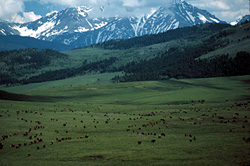
- The Viable Ranch
— to give a group of people, who could not otherwise afford
it, the possibility to purchase -- and live as often as they wish upon
-- a very
large piece of land. Not coincidentally, they would also be able to
take that land to a more harmonious, natural status, with increasingly
profitable,
sustainable food, fiber, and fuel production. These opportunities come
by combining, and fully respecting, (1) the positive feedback capabilities
inherent in native perennial plants, and (2) the multiple species of
animals that have adapted over eons to graze upon them, together with
(3) the higher
efficiency and lessened damage that would result from management using
much-lighter-weight technology. The concept also integrates human needs
for comfort with better
community organization, both of which can benefit greatly from more
natural system virtues. Throughout it, the dreams of the 1960's, and other
cooperative
living explorers, are scientifically evaluated, evolved, and matured.
Legal aspects, not least dealing with just what "ownership" means,
along with the complications of continuing human population growth, make
the possibilities vastly more difficult than their purely technical
aspects.
Status: extensive research, and rough text, completed in 1986; still searching for book publisher; looking forward to active cooperators. Some related information that I have assembled about the potential of bison is available on line.
- Riparian Zone Values — making the benefits of more natural river and stream corridors more commonly believable, and thereby, their area to expand. This does not imply that people should not live reasonably near streams, but that these areas need special care. As usual, that which benefits nature locally has many benefits for both nearby and more distant humans.
- Highly functional rail — creating more serious interest in alternative transportation systems for urban corridors, based on higher efficiency, lighter weight materials to get people moving several times faster (if they want to), more comfortably, and much more safely. Japanese bullet trains, in 50 years, have killed fewer people (none) than die every few hours on America's much slower, anything but "free"ways. Meanwhile, moving freight by rail is inherently at least three times efficient than by truck, and could be even more so.
- Trying to Make Sense of It All: A tangent memoir
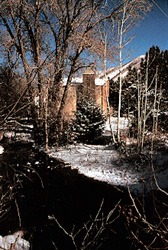
Status: basic story completed in 1995 and images integrated, looking for a publisher, while our own previously suburbanized property is being restored slowly and gently as a living example.
Status: preliminary organization phase, riding the existing system whenever feasible, and inclusion within discussions about the wider question of energy use.
The introduction for the currently 400+ page, thoroughly illustrated, typeset manuscript says early on, |
|
 |
Status: Eventually, still sometimes wielding a hose, I grew beyond this picture by my father, and leave the shadows. This is that story, now looking for a publisher. Pre-press samples and reservations may be arranged by subscription. |
... and on to art ...
- Willie Nelson's 1974 Picnic — from more than 125 highest quality original silver prints and text commissioned by the concert's producers, covering the second and largest
of these annual events. These start with the building of the stage at Texas World
Speedway, through
the better performances, and include samples from among its thousands of enchanted observers. An image from the book became the cover for Robert
Earl Keen's Picnic CD (on Arista-Austin in 1997), through recognizing the license number as the same as the one in Keen's tale
about
attending that picnic on his previous album, #2 Live Dinner. Other fascinating connections follow. Several modestly-sized,
draft quality versions of the images and associated text— including stage construction and in-performance
vignettes of Willie, Floyd Tillman, John Hartford, Guy Clark, and Waylon
Jennings — may be viewed through Silver
Eagles Taking Flight.
Status:A limited edition printed book version is available for $30 plus shipping through: High Level Press.

- Scenes of a Voyage: Scandinavia's winter
coastlines —
Why would anyone wish to head North, especially to the furthest that is more or less easily accessible, in February? For the beauty, of course, and in quest of cleaner air, among other reasons. The coastal voyage along Norway's fjords has become increasingly popular in summer, but in winter it can take on aspects paralleling the trawler photo (posted in the fisheries section above), or the one below, taken at Nordkapp (Europe's Arctic end), above 71 degrees North latitude. But it can also reflect the clearest sun, as in the Trondheim view, to the left. This collection of 108 color images of Norway, Denmark, and Iceland, with their associated stories, should be of interest to a wide audience, both in the U.S. and abroad.
As the book's introduction concludes,
"There are a great many compensations for this kind of travel, if one is willing to experience something outside the wastefully over-protected (and thus excessively polluted) daily life faced by most English speakers. For everyone, we hope that the images presented here will allow some of the best parts of the trip to be shared, without the necessity of repeating the screaming gales and cold. Beyond that, for the more adventurous, may they serve as a teaser to gather similar experiences in person."
Status: images integrated with text; more than half printed as fine quality examples. Searching for a quality publisher. A CDROM version, with full-computer-screen-sized images, is complete. Contact the author for more information.
A few more of my images, including several from the Norway book, are now posted in a collection.
Status: Viewable, with fuller quality prints and use permissions available.
- Lighten Up: Bringing
Technology into Harmony with People and Planet
— a still developing proposal for a comprehensive course, first prepared for an interactive CD-ROM
Status: on-line illustrated outline.
Other more or less completed efforts
intended for wider, albeit scientifically literate, audiences, |
|
| draft of | |
| 2016 | Long-Term Trends With And Without Grazing In The Sagebrush Ecosystem In Wyoming. Yorks, T.P., Fisser, H.G., Laycock, W.A., and Capels, K.M. [low resolution version: 642 kb file] |
| 2016 | Long-Term Trends With And Without Grazing In The Sagebrush Ecosystem In Wyoming. Yorks, T.P., Fisser, H.G., Laycock, W.A., and Capels, K.M. [high quality resolution: 52 MB file] |
| 2009 | Effectively Comparing Land User Impacts. Yorks, T.P. [begun in 1994; submitted to various possibilities as it evolved] |
| 2009 | Reducing energy consumption by 90%, with increased comfort. Yorks, T.P. [submitted to Orion in 2005] |
| 2016 | On Prairie Dogs and Coexistence with Other Species, Yorks, T.P. [originated in 1994 and submitted to various possibilities as it evolved] |
| 2004 | On Lightening Aircraft, Yorks, T.P. [submitted to the VP at Boeing most associated with innovation; received not even a reply] |
Yorksite Home Page / Education
/ Experience / Publications
/ Quotations / Slow Blog / Photographic Portfolio / Web
Trolls
other images, text , and site design © 1998, 2000, 2001, 2005, 2006, 2007, 2008, 2009, 2017, 2019 by Terence Yorks (contact), all rights reserved;
further distribution or postings in any form without written permission is strictly forbidden
page updated 4 December 2019

